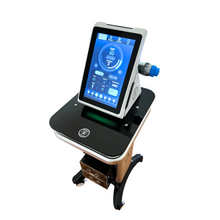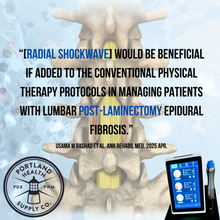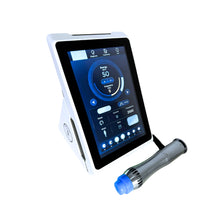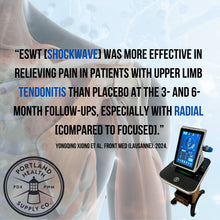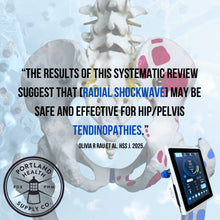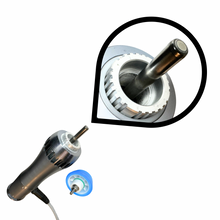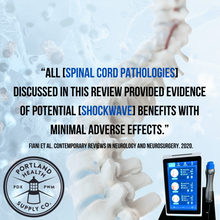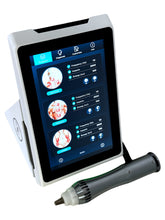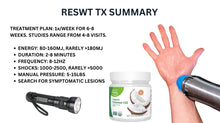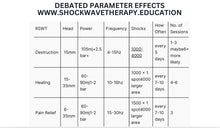
[Only Available For Qualified Healthcare Providers]
The PHS6B is an electromagnetic acoustic shockwave device that produces highly effective treatments for a wide range of musculoskeletal conditions.
Unlike pneumatic shockwave devices, the PHS6B produces radial shockwaves with electromagnetic acceleration. This eliminates the need for a mechanical air bladder, and improves portability and operational noise.
Electromagnetic shockwaves are produced when a projectile is accelerated towards an applicator creating a cavitation or sound wave. Upon impact, a wave is produced which propagates in radial direction from the applicator, which is why the highest energy and pressures are located directly at the applicators surface.
Intended use:
• to relieve minor muscle aches and pains
• temporary increase in local blood circulation
• activation of connective tissue (below 3bar for best results)
Potential benefits:
• stimulation of cell permeability, hormones, stem cells, and angiogenesis
• dissolving calcified fibroblasts
Specifications:
• Energy; 30-210mj (1-6 Bar)
• Frequency; 1-16Hz
• Continuous or multi-model settings
• Power Source; 100-240VA 50/60Hz
• Power Input; 350W
• Weight; 3KG
• Dimensions; 330 x 133 x 244mm
Contraindications:
•lungs, heart, brain, eyes, and other organs
• wounds, infected areas, skin tumors, open sores, or scars from recent surgery
• use in the presence of malignant tumor
• in the region of a fetus or pregnant abdomen
• swollen or inflamed areas or skin eruptions
• clotting disorders or unexplained calf pain
• regions near large nerves, vessels
• clotting disorders or unexplained calf pain
• do not use in the presence of unexplained pain
• discontinue immediately if a patient reports significant or unexpected pain
• ALWAYS move the handpiece over the treatment area. Continuous repetitive pulses concentrated in one spot may lead to bruising.
• NEVER use this device on children, the unconscious, or anyone who cannot give verbal consent or warnings about pain.
Treatment expectations:
- Shock wave therapy is a non-invasive treatment option for various musculoskeletal conditions that uses high-energy sound waves to stimulate healing.
- Before starting the treatment, the patient's medical history should be reviewed, and a physical examination should be conducted to determine the suitability of the treatment.
- The treatment involves applying a probe to the affected area and delivering shock waves to the tissue using a machine.
- The intensity of the shock waves can be adjusted based on the patient's tolerance and the severity of the condition.
- The treatment session usually lasts between 15 and 30 minutes, and the number of sessions required depends on the condition being treated.
- The patient may experience mild discomfort during the treatment, but it should not be painful.
- After the treatment, the patient may experience some soreness, swelling, or bruising, but this usually resolves within a few days.
- The patient should avoid any strenuous activity or exercise for at least 24 hours after the treatment.
- Shock wave therapy is generally safe, but there are some potential risks, including skin injury, nerve damage, and pain.
- Patients should discuss the risks and benefits of the treatment with their healthcare provider before undergoing shock wave therapy.
Treatment settings:
The recommended settings for radial shockwave therapy can vary depending on the specific condition being treated and the patient's individual needs. However, here are some common radial shockwave settings for five different joint regions:
-
Shoulder joint: The recommended frequency for treating shoulder joint conditions with radial shockwave therapy is typically between 5-10 Hz, with an intensity of 1.5-3.0 bar. The treatment session usually lasts between 10-15 minutes, and the number of sessions required depends on the severity of the condition.
-
Elbow joint: The recommended frequency for treating elbow joint conditions with radial shockwave therapy is typically between 5-8 Hz, with an intensity of 1.5-2.5 bar. The treatment session usually lasts between 5-10 minutes, and the number of sessions required depends on the severity of the condition.
-
Hip joint: The recommended frequency for treating hip joint conditions with radial shockwave therapy is typically between 5-10 Hz, with an intensity of 1.5-3.0 bar. The treatment session usually lasts between 15-20 minutes, and the number of sessions required depends on the severity of the condition.
-
Knee joint: The recommended frequency for treating knee joint conditions with radial shockwave therapy is typically between 5-10 Hz, with an intensity of 1.5-3.0 bar. The treatment session usually lasts between 10-15 minutes, and the number of sessions required depends on the severity of the condition.
-
Ankle joint: The recommended frequency for treating ankle joint conditions with radial shockwave therapy is typically between 5-8 Hz, with an intensity of 1.5-2.5 bar. The treatment session usually lasts between 5-10 minutes, and the number of sessions required depends on the severity of the condition.
It is important to note that these settings are just general guidelines, and healthcare providers who are experienced in using radial shockwave therapy should determine the most appropriate settings for each patient's specific condition.
Additional resources for shockwave settings and attachments:
Basic Operation:
Insert the power plug in Figure 3.1 into ac100-240V wall power, and then press the power switch on the back panel of the host to open the system.As shown in the figure, the device enters the power-on animation interface.
Click the device lock icon in the upper left corner of the interface to enter the password input interface. Click the "User Password" secret in Figure 3.6 Code input box, enter The Times recharge password provided by our company, and click OK. The interface appears when the password is entered correctly prompt for Recharge "Recharge Successful", click "Confirm" and return to the main interface.
Treatment parameters are divided into four modes: continuous, every 4 cycles, every 8 cycles and every 12 cycles.(For example, every 4 cycles means that the foot pedal switch does not move, and the treatment head stops after launching shock wave for 4 times. Release the foot switch and launch again.
The adjustable range of frequency and energy in each mode is as follows:
When frequency is set at 1 - 8Hz, the energy can be set at 60 - 210MJ;
When frequency setting is 9 - 15 Hz, the energy can be set to 60 - 190- (frequency-9) x10 MJ;
When the frequency is set at 16Hz, the energy can be set at 60 - 130 MJ.
*Note: when the handle is running and the treatment head is firing the shock wave, the parameters cannot be adjusted. It is necessary to release the foot switch to suspend the firing adjust parameters.
Starting treatment:
Remove the handle from the base stand, press the end of the treatment head on the target tissue, step on the foot switch, and the treatment head starts to emit shockwaves. Move the handle slowly in circles, covering all areas of pain, gradually increasing to patient tolerance (mild discomfort).
Note: In clinical practice, the physician sets the parameters according to the individual patient.
Ending treatment:
When the number of shockwaves reaches the pre-selected value of 15000, the first treatment is finished. At this time, the password must be re-entered to initiate the next treatment.
Warranty:
This product includes a 2 year comprehensive warranty, and 30 day return policy. All shockwave machines require replacements of moving parts every 1-2 years, but our maintenance is a fraction of the cost of our competitors.
FDA registration: Lotuxs









